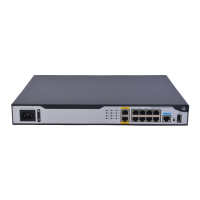220
RMON samples the monitored alarm variable at the specified sampling interval, compares the sampled
value with the predefined thresholds, and does one of the following:
• Triggers the event associated with the rising alarm if the sampled value is equal to or greater than
the rising threshold.
• Triggers the event associated with the falling alarm if the sampled value is equal to or less than the
falling threshold.
Examples
# Create an alarm entry to perform absolute sampling on the number of octets received on
GigabitEthernet 2/0/1 (object instance 1.3.6.1.2.1.16.1.1.1.4.1) at 10-seconds intervals. If the sampled
value reaches or exceeds 5000, log the rising alarm event. If the sampled value is equal to or less than
5, take no actions.
<Sysname> system-view
[Sysname] rmon event 1 log
[Sysname] rmon event 2 none
[Sysname] interface gigabitethernet 2/0/1
[Sysname-GigabitEthernet2/0/1] rmon statistics 1
[Sysname-GigabitEthernet2/0/1] quit
[Sysname] rmon alarm 1 1.3.6.1.2.1.16.1.1.1.4.1 10 absolute rising-threshold 5000 1
falling-threshold 5 2 owner user1
In this example, you can replace 1.3.6.1.2.1.16.1.1.1.4.1 with etherStatsOctets.1, where 1 is the statistics
entry index for the interface. If you execute the rmon statistics 5 command, you can use
e t h e r S t a t s O c t e t s . 5 t o re p l a c e 1.3. 6 .1. 2.1.16 .1.1.1. 4 .5.
Related commands
• display rmon alarm
• rmon event
rmon event
Use rmon event to create an entry in the RMON event table.
Use undo rmon event to remove an entry from the RMON event table.
Syntax
rmon event entry-number [ description string ] { log | log-trap security-string | none | trap security-string }
[ owner text ]
undo rmon event entry-number
Default
No entry exists in the RMON event table.
Views
System view
Predefined user roles
network-admin
Parameters
entry-number: Specifies an event entry index in the range of 1 to 65535.

